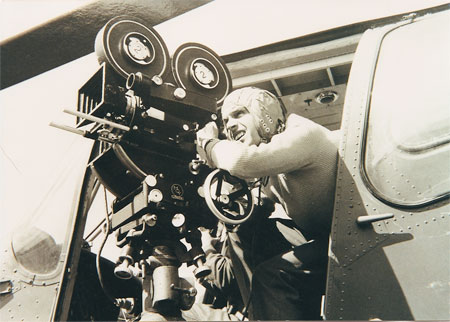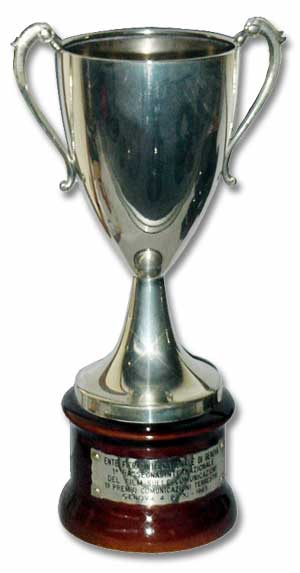The late David Watkin - Oscar-winning Cinematographer - reminisced about his time filming Blue Pullman. www.davidwatkin.co.uk Blue Pullman, 1960 was directed and written by Jimmie Ritchie and photographed by David Watkin and Jack West. It was edited by Hugh Raggett with music by Clifton Parker. The film was shot in colour and lasts almost 23 minutes, exploring the intensive testing of the new 90mph diesel-electric Midland Pullman, and its maiden journey from Manchester to London. Hugh Raggett writes to me (September 2009) that the film is not a good transfer from the 35mm original “a shame because the colour is far too bright and harsh, the original show copies had more fine detail and were softer.” Far from being a utilitarian presentation of the steps needed to test this new train, the film is an elaboration of surface and designed style, set at the beginning as a sort of murder mystery complete with headless body on the floor. Clifton Parker’s music is a set of variations on Bartok’s Concerto for Orchestra, an ominous backing to technical equipment swaying in the motion of the carriage, with wires, string, cables, and an abandoned set of headphones on a seat. Both lavatories are in use, one as a Dark Room, the other to house testing equipment. Throughout the film, incidentally, we are spared the Narrator’s voice. The silky flow of the camera through the unoccupied carriages adds to the sense of unease. Suddenly the train goes into a tunnel and, reflected in the darkened window, are two technicians in shirtsleeves. A magical moment. Slowly the viewer pieces together the function of this journey, a series of still lives, shots of documents, the paraphernalia of catering, the mechanics of the trajectory. The point of view switches to the Driver’s Cab, and then the tracks leading into the Engine Shed. The doors close. At this journey’s end we see the assessment of the train’s performance through a montage of documentation and earnest brows. We then cut to a still life of machine parts in action, but this time, it is the printing of posters advertising the new de-luxe Pullman service, and the printing of the dedicated menus. In the third section, we see the Completion of Trials certificate and glimpses of staff being trained in the use of the apparatus of luxury – air conditioning, lighting, blinds. The fourth section of the film is devoted to the first working journey of the train, non-stop from Manchester Central to London St. Pancras. The service was aimed at the business classes and it shows. The middle aged men with briefcases take their seats. Only a flirtatious glance from one young buck through the seats to a token bimbo disturbs the atmosphere of the Financial Times and self importance. One later section of a close-up of a passenger’s face and out of focus shots of the attendant’s jacket clearly implies a sleepy haze induced by the combination of alcohol and travel by rail. The last minutes of the film show the train catching up time, hurtling though the landscape, filmed from on-board, from the point of view of track workers, from a station platform, and, memorably, from a helicopter, edited with gusto by Hugh Raggett. It is no surprise by now that the Blue Pullman is on time arriving at 11 a.m. by the Hotel Clock at St.Pancras, to the enormous satisfaction of all involved. David never expressed any particular satisfaction about his film, always singling out Holiday as the height of his achievement at BTF. In Clara he writes, “There was something of an education on the next film Ritchie directed, about a new high-speed diesel-electric Pullman service, in as much as it involved a helicopter sequence. The pilot, John Crewdson, had the machine on a landing pad in his nicely tended garden in Surrey, and we took off from there to fly up to Derbyshire, stopping at Elstree airfield to refuel. John walked me round the hangar there and showed me an autogyro, the safest plane there is (and banned accordingly).The NC Mitchell was on a Moy head, mounted on a dexian platform outboard the aircraft. On the start line, attired in one of those leather flying helmets with a throat mike and earphones, I was more than a little anxious – that is until a camp 1st assistant, David McKeand, jollied things up. “You look like Amy Johnson.” It was exactly what was needed and when we lifted off I was still pissing myself. The moment I unlocked the Moy it became a different world. It is how people do hazardous jobs – once you’re working that’s where you’re focussed. John’s comments were a delight, “Fucking snail!”, when the train had to slow down for engineering works. However when the fucking snail got going we were pushed to keep up with it. At one point, with the train on an embankment, we were below it tilted up – and the hedge-hopping was literal. After one hedge a “Whoops” from John led me to enquire what had happened.”There was an old cunt on a tractor I hadn’t spotted ‘cos of the hedge.”…” Hugh Raggett writes, “The last sequence of the train at speed was shot and intercut between the helicopter and another train on a convenient piece of rail track that ran near the Blue Pullman line for a mile or so.” Is there any other evidence of David’s particular talents in this film? Objects settle in precise, shining still lives – glasses, switches, dials, and there is an early statement of intention in the lighting of the spectacles on an open book. One arrangement of drinks on a table with the blinds drawn (see above) has a feel of the drinks commercials he was doing at the time. There is a fascination with surfaces that change and reveal reflections and then change back. A couple of scenes have darkened figures in the foreground look out to a brightly lit background. There is also a highly sympathetic depiction of the technicians and workers, who, despite their clunky dialogue, seem at ease in what they do, and somehow celebrated. Hugh Raggett reveals however that, “apart from the railway personnel all the rest are paid extras – perhaps too type-cast for this age, or even that one.” A peculiar scene that starts off with the dusting down of the Stationmaster’s top hat has perhaps a hidden agenda regularly referred to throughout Blue Pullman involving status and uniform. It is impossible to disentangle contributions to the film’s excellence. David, I know, would have paid tribute to working with Jimmy and Hugh.Hugh remembers Blue Pullman as “a big production for BTF that gathered several awards and ran for three weeks at the Odeon Marble Arch, looking far better than it does on DVD! As an editor looking at it again after nearly fifty years I see all my mistakes – for instance, the soundtrack is too thin and needs far more life with sound effects and conversation. The whole film was shot silent and all dialogue was added at the editing stage – i.e. I recognise my own voice explaining the air-conditioning!” Additional information: Click HERE to view a website on the history of these once prestigeous units at railcar.co.uk. A Yahoo E-group exists for anyone interested in the erstwhile British Rail Blue Pullman sets which operated between London and Manchester / Birmingham / South Wales. Please feel free to contribute any photographs, memories, etc. Click HERE for more details.


This film won the Silver Cup in 1965 at Genoa, Italy